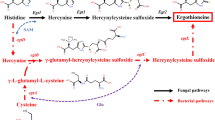Abstract
Poly-γ-glutamic acid (γ-PGA) is a novel biodegradable polyamide material. Microbial fermentation is the only way to produce γ-PGA, but the molecular weight of γ-PGA varied depending on different strains and culture conditions used. The molecular weight of γ-PGA is a main factor affecting the utilization of γ-PGA. It is urgent to find an efficient way to prepare γ-PGA with specific molecular weight, especially low molecular weight. Bacillus subtilis ECUST is a glutamate-dependent strain that produces γ-PGA. In this study, a recombinant B. subtilis harboring the γ-PGA synthase gene cluster pgsBCAE of our preciously identified γ-PGA–producing B. subtilis ECUST was constructed. Assay of γ-PGA contents and properties showed that recombinant B. subtilis 1A751-pBNS2-pgsBCAE obtained the ability to synthesize γ-PGA with low molecular weight (about 10 kDa). The excessive addition of glutamate inhibited the γ-PGA synthesis, while the addition of Zn2+ could promote the synthesis of γ-PGA by increasing the transcription of pgsB but had no effect on the molecular weight of synthesized γ-PGA. Under optimized conditions, γ-PGA produced by recombinant B. subtilis 1A751-pBNS2-pgsBCAE increased from initial 0.54 g/L to 3.9 g/L, and the glutamate conversion rate reached 78%. Recombinant B. subtilis 1A751-pBNS2-pgsBCAE has the potential for efficient preparation of low molecular weight γ-PGA.




Similar content being viewed by others
Abbreviations
- CTAB:
-
cetyltrimethylammonium bromide
- γ-PGA:
-
poly-γ-glutamic acid
- PCR:
-
polymerase chain reaction
- TLC:
-
thin-layer chromatography
- SDS-PAGE:
-
sodium dodecyl sulfate polyacrylamide gel electrophoresis
References
Ashiuchi, M., Shimanouchi, K., Nakamura, H., Kameil, T., Soda, K., Park, C., Sung, M., & Misono, H. (2004). Enzymatic synthesis of high-molecular-mass poly-γ-glutamate and regulation of its stereochemistry. Applied and Environmental Microbiology, 70(7), 4249–4255.
Chatterjee, P. M., Datta, S., Tiwari, D. P., Raval, R., & Dubey, A. K. (2018). Selection of an effective indicator for rapid detection of microorganisms producing γ-polyglutamic acid and its biosynthesis under submerged fermentation conditions using Bacillus methylotrophicus. Applied Biochemistry and Biotechnology, 185(1), 270–288.
Zhao, C., Zhang, Y., Wei, X., & Hu, Z. (2013). Production of ultra-high molecular weight poly-γ-glutamic acid with Bacillus licheniformis P-104 and characterization of its flocculation properties. Applied Biochemistry and Biotechnology, 170(3), 562–572.
Tan, J., Wang, H., Xu, F., Chen, Y., Zhang, M., & Peng, H. (2017). Poly-γ-glutamic acid-based GGT-targeting and surface camouflage strategy for improving cervical cancer gene therapy. Journal of Materials Chemistry B, 5(6), 1315–1327.
Guo, Z., Na, Y., Zhu, C., & Gan, L. (2017). Exogenously applied poly-γ-glutamic acid alleviates salt stress in wheat seedlings by modulating ion balance and the antioxidant system. Environmental Science & Pollution Research, 24(7), 1–7.
Shih, I. L., & Van, Y, T. (2001). The production of poly-(γ-glutamic acid) from microorganisms and its various applications. Bioresource Technology, 79, 207–225, 3.
Ashiuchi, M., Kamei, T., Baek, D. H., Shin, S. Y., Sung, M. H., & Soda, K. (2001). Isolation of Bacillus subtilis (chungkookjang), a poly-gamma-glutamate producer with high genetic competence. Applied Microbiology and Biotechnology, 57(5–6), 764–769.
Peng, Y., Jiang, B., Zhang, T., Mu, W., Miao, M., & Hua, Y. (2015). High-level production of poly (γ-glutamic acid) by a newly isolated glutamate-independent strain, Bacillus methylotrophicus. Process Biochemistry, 50(3), 329–335.
Feng, J., Shi, Q., Zhou, G., Wang, L., Chen, A., Xie, X., Huang, X., & Hu, W. (2017). Improved production of poly-γ-glutamic acid with low molecular weight under high ferric ion concentration stress in Bacillus licheniformis ATCC 9945a. Process Biochemistry, 56, 30–36.
Tian, G., Fu, J., Wei, X., Ji, Z., Ma, X., Qi, G. F., & Chen, S. W. (2014). Enhanced expression of pgdS gene for high production of poly-γ-glutamic aicd with lower molecular weight in Bacillus licheniformis WX-02. Journal of Chemical Technology Biotechnology, 89(12), 1825–1832.
Suzuki, T., & Tahara, Y. (2003). Characterization of the Bacillus subtilis ywtD gene, whose product is involved in gamma-polyglutamic acid degradation. Journal of Bacteriology, 185(7), 2379–2382.
Luo, Z., Guo, Y., Liu, J., Hua, Q., Zhao, M., Zou, W., & Li, S. (2016). Microbial synthesis of poly-γ-glutamic acid: current progress, challenges, and future perspectives. Biotechnology for Biofuels, 9(1), 134.
Ashiuchi, M., Soda, K., & Misono, H. (1999). A poly-gamma-glutamate synthetic system of Bacillus subtilis IFO 3336: gene cloning and biochemical analysis of poly-gamma-glutamate produced by Escherichia coli clone cells. Biochemical & Biophysical Research Communications, 263(1), 6–12.
Jiang, H., Shang, L., Yoon, S. H., Lee, S. Y., & Yu, Z. (2006). Optimal production of poly-gamma-glutamic acid by metabolically engineered Escherichia coli. Biotechnology Letters, 28(16), 1241–1246.
Cao, M., Geng, W., Liu, L., Song, C., Xie, H., Guo, W., Jin, Y., & Wang, S. (2011). Glutamic acid independent production of poly-γ-glutamic acid by Bacillus amyloliquefaciens LL3 and cloning of pgsBCA genes. Bioresource Technology, 102(5), 4251–4257.
Lin, B., Li, Z., Zhang, H., Wu, J., & Luo, M. (2016). Cloning and expression of the γ-polyglutamic acid synthetase gene pgsBCA in Bacillus subtilis WB600. BioMed Research International, 2016(6), 1–7.
Sawada, K., Araki, H., Takimura, Y., Masuda, K., Kageyama, Y., & Ozaki, K. (2018). Poly- l -gamma-glutamic acid production by recombinant Bacillus subtilis, without pgsA, gene. AMB Express, 8(1), 110.
Sirisansaneeyakul, S., Cao, M., Kongklom, N., Chuensangjun, C., Shi, Z., & Chisti, Y. (2017). Microbial production of poly-γ-glutamic acid. World Journal of Microbiology and Biotechnology, 33(9), 173.
Cao, M., Feng, J., Sirisansaneeyakul, S., Song, C., & Chisti, Y. (2018). Genetic and metabolic engineering for microbial production of poly-γ-glutamic acid. Biotechnology Advances, 36(5), 1424–1433.
Cai, D., He, P., Lu, X., Zhu, C., Zhu, J., & Zhan, Y. (2017). A novel approach to improve poly-γ-glutamic acid production by NADPH regeneration in Bacillus licheniformis WX-02. Scientific Reports, 7(1), 43404.
Cai, D., Chen, Y., He, P., Wang, S., Mo, F., & Li, X., Wang Q., Nomura C.T., Wen Z., Ma X., Chen S. (2018). Enhanced production of poly-γ-glutamic acid by improving ATP supply in metabolically engineered Bacillus licheniformis. Biotechnology & Bioengineering, 115, 10, 2541, 2553.
Spizizen, J. (1958). Transformation of biochemically deficient strains of Bacillus subtilis by deoxyribonucleate. Proceedings of the National Academy of Sciences, 44(10), 1072–1078.
Wei, X., Tian, G., Ji, Z., & Chen, S. (2015). A new strategy for enhancement of poly-γ-glutamic acid production by multiple physicochemical stresses in Bacillus licheniformis. Journal of Chemical Technology & Biotechnology, 90(4), 709–713.
Goto, A., & Kunioka, M. (2014). Biosynthesis and hydrolysis of poly(-glutamic acid) from IF03335. Bioscience, Biotechnology, and Biochemistry, 56(7), 1031–1035.
Kambourova, M., Tangney, M., & Priest, F. (2001). Regulation of polyglutamic acid synthesis by glutamate in Bacillus licheniformis and Bacillus subtilis. Applied and Environmental Microbiology, 67(2), 1004–1007.
Yamaguchi, F., Ogawa, Y., Kikuchi, M., Yuasa, K., & Motai, H. (1996). Detection of γ-polyglutamic acid (γ-PGA) by SDS-PAGE. Bioscience, Biotechnology, and Biochemistry, 60(2), 255–258.
Kongklom, N., Luo, H., Shi, Z., Pechyen, C., Chisti, Y., & Sirisansaneeyakui, S. (2015). Production of poly-γ-glutamic acid by glutamic acid-independent Bacillus licheniformis TISTR 1010 using different feeding strategies. Biochemical Engineering Journal, 100(15), 67–75.
Ashiuchi, M., Kamei, T., & Misono, H. (2003). Poly-γ-glutamate synthetase of Bacillus subtilis. Journal of Molecular Catalysis B Enzymatic, 23(2), 101–106.
Kamei, T., Yamashiro, D., Horiuchii, T., Minouchi, Y., & Ashiuchi, M. (2010). Identification and biochemical characterization of membranous short-chain polyglutamate from Bacillus subtilis. Chemistry & Biodiversity, 7(6), 1563–1572.
Yamashiro, D., Yoshioka, M., & Ashiuchi, M. (2015). Bacillus subtilis pgsE (formerly ywtc) stimulates poly-γ-glutamate production in the presence of zinc. Biotechnology and Bioengineering, 108(1), 226–230.
Yu, W., Chen, Z., Ye, H., Liu, P., Li, Z., Wang, Y., Li, Q., Zhong, C., & He, N. (2017). Effect of glucose on poly-γ-glutamic acid metabolism in Bacillus licheniformis. Microbial Cell Factories, 16(1), 22.
Wu, Q., Xu, H., Xu, L., & Ouyang, P. (2006). Biosynthesis of poly(γ-glutamic acid) in Bacillus subtilis, NX-2: regulation of stereochemical composition of poly(γ-glutamic acid). Process Biochemistry, 41(7), 1650–1655.
Meng, Y., Dong, G., Zhang, C., Ren, Y., Qu, Y., & Chen, W. (2016). Calcium regulates glutamate dehydrogenase and poly-γ-glutamic acid synthesis in Bacillus natto. Biotechnology Letters, 38(4), 673–679.
Huang, B., Qin, P., Xu, Z., Zhu, R., & Meng, Y. (2011). Effects of l2 on viscosity of culture broth, and on activities of enzymes around the 2-oxoglutarate branch in Bacillus subtilis CGMCC 2108 producing poly-(γ-glutamic acid). Bioresource Technology, 10(2), 3595–3598.
Ashiuchi, M. (2010). Occurrence and biosynthetic mechanism of poly-gamma-glutamic acid. In Amino-acid homopolymers occurring in nature (pp. 77–93). Berlin Heidelberg: Springer.
Mitsunaga, H., Meissner, L., Büchs, J., & Fukusaki, E. (2016). Branched chain amino acids maintain the molecular weight of poly(γ-glutamic acid) of Bacillus licheniformis, ATCC 9945 during the fermentation. Journal of Bioscience and Bioengineering, 122(4), 400–405.
Do, T. H., Suzuki, Y., Abe, N., Kaneko, J., Itoh, Y., & Kimura, K. (2011). Mutations suppressing the loss of DegQ function in Bacillus subtilis (natto) poly-γ-glutamate synthesis. Applied and Environmental Microbiology, 77(23), 8249–8258.
Feng, J., Gu, Y., Quan, Y., Cao, M., Gao, W., Wei, Z., et al. (2015). Improved poly-γ-glutamic acid production in Bacillus amyloliquefaciens, by modular pathway engineering. Metabolic Engineering, 32, 106–115.
Ohsawa, T., Tsukahara, K., & Ogura, M. (2009). Bacillus subtilis response regulator DegU is a direct activator of pgsB transcription involved in gamma-poly-glutamic acid synthesis. Bioscience, Biotechnology, and Biochemistry, 73(9), 2096–2102.
Funding
This work is financially supported by the National Key Research and Development Program of China (2017YFB0309302), the National High Technology Research and Development Program of China (863 Program) (No. SS2014AA021202), and “Shu Guang” project of Shanghai Municipal Education Commission and Shanghai Education Development Foundation (15SG28).
Author information
Authors and Affiliations
Corresponding authors
Ethics declarations
Conflict of Interest
The authors declare that they have no conflict of interest.
Additional information
Publisher’s Note
Springer Nature remains neutral with regard to jurisdictional claims in published maps and institutional affiliations.
Rights and permissions
About this article
Cite this article
Jiang, S., Fan, L., Zhao, M. et al. Enhanced Low Molecular Weight Poly-γ-Glutamic Acid Production in Recombinant Bacillus subtilis 1A751 with Zinc Ion. Appl Biochem Biotechnol 189, 411–423 (2019). https://doi.org/10.1007/s12010-019-03004-2
Received:
Accepted:
Published:
Issue Date:
DOI: https://doi.org/10.1007/s12010-019-03004-2




